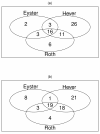A cross-study gene set enrichment analysis identifies critical pathways in endometriosis
- PMID: 19735579
- PMCID: PMC2752458
- DOI: 10.1186/1477-7827-7-94
A cross-study gene set enrichment analysis identifies critical pathways in endometriosis
Abstract
Background: Endometriosis is an enigmatic disease. Gene expression profiling of endometriosis has been used in several studies, but few studies went further to classify subtypes of endometriosis based on expression patterns and to identify possible pathways involved in endometriosis. Some of the observed pathways are more inconsistent between the studies, and these candidate pathways presumably only represent a fraction of the pathways involved in endometriosis.
Methods: We applied a standardised microarray preprocessing and gene set enrichment analysis to six independent studies, and demonstrated increased concordance between these gene datasets.
Results: We find 16 up-regulated and 19 down-regulated pathways common in ovarian endometriosis data sets, 22 up-regulated and one down-regulated pathway common in peritoneal endometriosis data sets. Among them, 12 up-regulated and 1 down-regulated were found consistent between ovarian and peritoneal endometriosis. The main canonical pathways identified are related to immunological and inflammatory disease. Early secretory phase has the most over-represented pathways in the three uterine cycle phases. There are no overlapping significant pathways between the dataset from human endometrial endothelial cells and the datasets from ovarian endometriosis which used whole tissues.
Conclusion: The study of complex diseases through pathway analysis is able to highlight genes weakly connected to the phenotype which may be difficult to detect by using classical univariate statistics. By standardised microarray preprocessing and GSEA, we have increased the concordance in identifying many biological mechanisms involved in endometriosis. The identified gene pathways will shed light on the understanding of endometriosis and promote the development of novel therapies.
Figures



References
-
- Sha G, Wu D, Zhang L, Chen X, Lei M, Sun H, Lin S, Lang J. Differentially expressed genes in human endometrial endothelial cells derived from eutopic endometrium of patients with endometriosis compared with those from patients without endometriosis. Hum Reprod. 2007;22:3159–3169. doi: 10.1093/humrep/dem266. - DOI - PubMed
Publication types
MeSH terms
LinkOut - more resources
Full Text Sources
Medical

